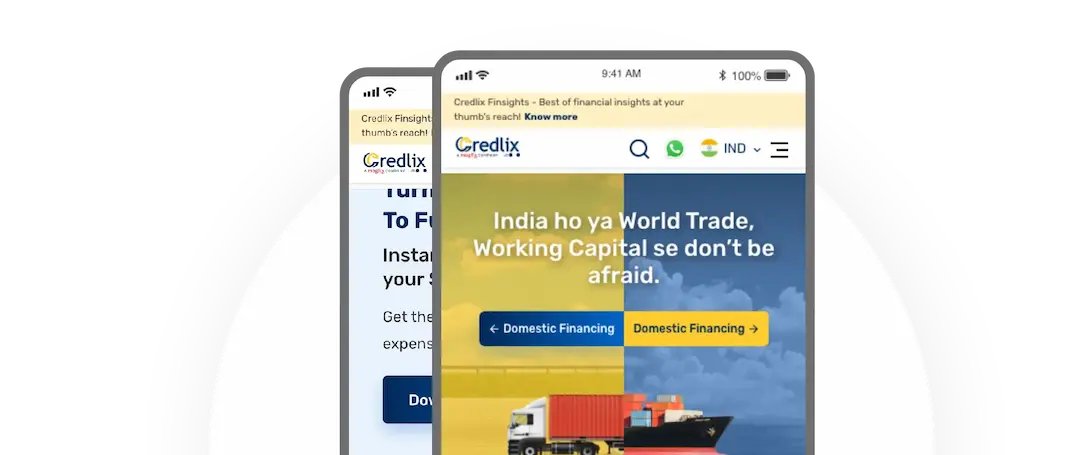International trade has always been one of the key drivers in global commerce, allowing countries to trade goods and services across borders which argue for economic interdependence that leads to a more robust economy globally. In practice, international trade can be complex with different regulations and requirements depending on the market which means businesses often need financial help. While there are many types of global trade finance, few may be as useful or potent in this part of the armory for global commerce than a line-of-credit. We will examine what lines of credit for international trade are, why they matter and how they are changing the world economy by 2024 in this blog.
Understanding Lines of Credit in International Trade
A line of credit is a type of loan similar to working capital offered by a bank in a market where you can borrow the entire amount based on your requirement, repay it immediately or heavier minimum payment maintaining limit for further drawdown. Lines of credit are procured to pay foreign suppliers in international trade. Whether it is about buying raw materials, the sellers offer the required working capital to ensure that businesses keep ticking even if there are no cash-flow disruptions in operations.
Key Features of Lines of Credit for International Trade
Revolving Credit
Did you know that a line of credit is considered revolving? Businesses are free to take the funds, return them and then come back for more whenever they want. International trade can have tough payment cycles and be flexible.
Currency Flexibility
Trade lines of credit can be issued in a variety of different currencies, allowing businesses to better manage exchange rate risks It is especially crucial for 2024, with exchange rate fluctuations remaining a key worry amongst international retailers.
Short-Term Financing
For businesses which require quick access to funds within a short term, this line of credit is mostly aligned with the import export finance requirements for transaction purposes. The terms typically last from three months to a year, depending on the agreement made by both of them.
Collateral Requirements
However, lines of credit often lack the collateral requirements which are common with term loans. This can be in the form of accounts receivable, inventory or current merchandise being traded.
Interest Rates and Fees
Line of credits come with low-interest rates compared to alternatives, which can be as little as 4% or sometimes a bit more based on the criteria such credibility, worthiness and the amount borrowed. Lines of credit have been selected as an alternative financing tool for trade finance by the firms because apparently interest rates in 2024 have little changed.
Why are lines of credit so important in global trade transactions?
Facilitating Global Expansion
Access to lines of credit is essential for businesses looking to expand their operations internationally. Even without hitting the ceiling, international markets are huge potential areas of growth for a startup but very risky and costly. Credit lines are used to fund the operation (e.g., waiting for foreign customers to pay, money-on-account purchases) and obtain operating capital needed to enter a new market.
World trade will increase 3.2% in 2024 (WTO) This increase is fueled by burgeoning consumption in emerging markets, especially Asia and Africa. Yet, being able to enter these markets can come with a significant price tag and access to lines of credit is one way businesses turn this into reality – even if it has its own set of financial challenges.
Managing Cash Flow
Cash flow management reigns as one of the most consistent root causes for international trade becoming complicated and expensive. One common problem is having to wait for a long time till the payment cycles of businesses. It offers ongoing, flexible access to cash that helps companies smooth out the highs and lows of their operating cycle — think paying suppliers (and increasing inventory levels) before getting paid.
For example, a business that sells items abroad to one or more customers in Europe may need 60–90 days after the goods are shipped before it is paid (Slattery et al. 2010). The company may still need to service the value added chain, its suppliers and employees etc during this time period. A line of credit enables the business to continue normal operation without delay for collecting payment.
Mitigating Risks
Political instability, changing in currency exchange rate and new trade regulations are just some of the risks associated with international trades. All of these risks can affect a business to pay suppliers, holding inventory in events or fulfill orders. A flexible line of credit is a financial safety net that enables businesses to withstand these variables without having an impact on the overall operation.
Typically, in 2024 there is more volatility evident in currency markets due to rising geopolitical tensions within some regions. Moreover, firms doing business in the global value chain can utilize lines of credit as a bulwark against currency risks to have enough money on hand if things turn sour.
Enhancing Supplier Relationships
Strong supplier relationships are a key to international trade success. Then suppliers definitely will treat those businesses more seriously or right out the gate. A line of credit allows businesses to be able to pay their bills on time while they are waiting for payment from customers. This not only installs confidence with suppliers but means businesses are more likely to be in a stronger position from which they can negotiate — being offered early payment discounts or longer payment schedules.
Supporting Innovation and Competitiveness
Innovation is the key to competitiveness in a global market. Lines of credit offer the financial flexibility that companies need to invest in research and development, expand into new markets or adopt innovative technologies. In 2024, access to capital via lines of credit is even more existential as businesses continue the relentless path toward digital transformation and automation.
Example: A business may use a line of credit to buy new manufacturing equipment that allows for higher production while lowering cost. Not just an advantage for the business, but a long term stable investment in competitive edge on a global stage.
Also Read: Top 5 Ways To Finance Your International Trade/Export Business in 2024
Types of Lines of Credit for International Trade
Businesses can take advantage of different types of lines of credit that they may use to fund international trade. They service different needs and serve their purpose separately. Let’s take a closer look at some of the more common types:
1. Trade Credit Line
A trade credit line is especially designed for the businesses engaged in international trade. It is actually short term financing in nature and the reason customers want to buy goods & services from foreign suppliers. Trade partners/ banks and financial institutions specializing in trade finance offer trade credit lines.
Over the past few years, trade credit lines have become more and more requested from small to medium-sized enterprises (SMEs) as they globalize their businesses into 2024. Trade credit lines represented roughly 30% of all trade finance transactions in 2023, as outlined by the International Chamber of Commerce (ICC).
2. Export Credit Line
An export credit line is a form of pre-defined loan to support companies engaged in the export. In this sense, it is a s working capital to cover production and shipping costs of goods outside the country. Export credit lines are not uncommon and they typically have the backing of export credit agencies (ECAs) or government programs that encourage exports.
And in 2024, demand for export credit lines surge as corporations flock to the new frontiers of SMN and Sierra tango. In fact, the Export-Import Bank of the United States (EXIM) reported a 15% jump in export credit lines during Q1/2024 — all-time record production driven by rising demand for US goods from Asia and Latin America.
3. Import Credit Line
A financial assistance program that enables businesses to purchase goods and services from foreign suppliers. This is what provides the capital required to pay for imports so that businesses can achieve more predictable management of cash flow and reduce down time in their supply chain.
Import credit lines have emerged as a necessity in 2024 due to mounting supply chain difficulties and escalating import prices for companies. At the same time, a veteran World Bank report said global import costs are estimated to be 4% higher in 2024 because of rising fuel prices and logistical woes. By helping to solve these challenges, import credit lines help provide businesses with the financial support they need in order for them to continue getting uninterrupted flow of goods.
4. Revolving Credit Line
Revolving credit lines are special flex-terms for borrow, repay and reborrow up to a staggering pre-negotiated line of credit. It is perfect if you are a budding business with inconsistent needs for cash flow, because it offers you permanent revolving access to funds without having to apply and get approval of loan every time.
Revolving credit facilities are most commonly used in international trade, where businesses must finance their operations through multiple revolving transactions done over much longer periods. For the five years in 2024, adaptable credit lines have picked up energy among exporters and shippers searching for more proficient working capital administration.
5. Standby Letter of Credit
A standby letter of credit is a form of financial guarantee that a bank will offer to pay the beneficiary if their buyer fails to live up to its obligation. An SBLC is not a line of credit per se, but it works as a type of credit enhancement which gives both buyers and sellers in international trade the assurance that they require.
Early 2024 — To alleviate payment risks and develop confidence between enterprises and overseas partners, the usage of SBLCs in economic activities has grown widely throughout global trade. Trade finance Transactions — SBLC The same results from a 2018 ICC survey indicate that the SBLCs comprised some 20% of global Trade finance transactions in IMB; thereby re-asserting their importance in enabling safe trade.
Also Read: Types Of Trade Finance Products: Financing Foreign Trade
Technology and Lines of Credit for International Trade
Technology remains central to the evolution of lines of credit in global trade — and it will only ramp up more into 2024. By combining digital platforms the process of applying for lines of credit can be done at any time and easily.
Digital Platforms
The way companies leverage lines of credit has drastically changed through the utilization of digital trade finance platforms. These platforms also aggregate business loans from a network of institutional lenders which enables them to compare multiple offers and select the best possible option for their particular case. Digitalization of trade finance processes has also brought down the time taken to approve and disburse lines of credit essentially, allowing businesses access funds quicker.
Blockchain Technology
The use of blockchain technology is revolutionizing international trade finance by making the process transparent, secure and speedy. 2024 sees firms increasingly resorting to blockchain-assisted credit management solutions. It also builds trust among the participants by providing a verifiable and tamper-proof record of every transaction relevant to that trade, which eliminates fraud risks and ensures all involved have access to identical information on their transactions.
AI & ML
Artificial intelligence (AI) and machine learning are employed to analyze credit worthiness, forecast trends in the market whilst managing bookkeeping better than ever. Credit assessments supported through AI are maximizing lenders enabling lenders at 2024 to make better informed decisions with real-time data and predictive analytics enhancing business tailor made packages.
It uses AI to pinpoint red flags in global trade, such as currency swings or market conditions. Using vast quantities of data to delight with ideas, AI gives users the sense of using their lines-credit strategically most.
Also Read: A Complete Guide on Payment Methods in International Trade (2024)
Conclusion
In the fast-changing world of international trade lines of credit are invaluable enabling global businesses to take advantage, hedge risks and grow aggressively. For the foreseeable future past 2024, lines of credit will be a cornerstone in determining if businesses flourish or flounder on a larger level throughout targeted marketplaces around the globe.
Credlix is one of the prominent names in trade finance for businesses considering a trustworthy and innovative partner. Through its proprietary digital platform, Credlix provides a simple and effective way to finance trade lines. Whether you want to break into new markets, tighten your cash flow or implement long term trade sustainability — find financial solutions with Credlix for the future.
Also Read: Understanding International Trade Finance, Its Working and Types





